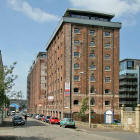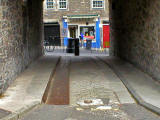|
Anderson Place Leith |
Looking south up Anderson Place - towards the junction with Bonnington Road
© John Stewart, Livingston, West Lothian, Scotland: Photograph taken Summer 2009
|
Recollections 1. John Stewart Livingston, West Lothian, Scotland |
|
Road Surface Thank you to John Stewart, Livingston, West Lothian, Scotland (formerly of Leith) for allowing me to reproduce this photo that he took in summer 2009. This view looks to the south up Anderson Place, towards its junction with Bonnington Road. looking south Here is a photo taken three years earlier, looking in the opposite direction - down the street towards Ferry Road: looking north |
|
Commenting on his photo at the top of this page, John wrote: Granite Setts and Smooth Tracks "I took this photo in Summer 2009. It shows the old smooth tracks set into the granite setts in Anderson Place on the incline to Bonnington Road. These were to assist the horse drawn coal carts coming up with their full load from the coal depot further down the road. As the carts approached this incline, a waiting trace horse was attached to assist the harnessed horse to get up the slope. This stretch of road is protected as a listed piece of thoroughfare." |
|
John added: Other Remains from the Past "In some parts of the city, there can be seen on buildings that bordered tram routes, signs of where the overhead trolley cables were attached. At the height of the first flat between windows, there are traces of where the anchor plate was bolted. If you imagine a diamond shape of about 12 inches high. Round off the top and bottom points and there can be seen the bolt holes now filled but a different shade from the surrounding stone. The whole plate was shaped like a shield. These can be seen clearly in Gorgie Road as you pass Smithfield coming into town on the left on the original tenements. They are about two lamp posts apart. Glasgow never removed its plates." |
|
John Stewart, Livingston, West Lothian, Scotland: December 9, 2009 |
|
Recollections 2. John Gray Stenhouse, Edinburgh |
|
Road Surface looking south After seeing this photograph of Anderson Place, John Gray wrote: |
|
Steel Tracks "Were there not steel tracks tracks on the incline in Anderson Place before the paving style track was installed, around the time of the bond being refurbished? I may be getting confused about the area, but I have definitely seen steel tracks on a road surface somewhere around Edinburgh and always wondered why they were there." John Gray, Stenhouse, Edinburgh: December 10, 2009 |
|
Reply to John? I don't know the answer to John's question above. If you know the answer, please email me, then I'll pass the message on to John. Thank you. Peter Stubbs: December 10, 2009 |
|
Recollections 3. John Stewart Livingston, West Lothian, Scotland |
|
Road Surfaces Thank you to John Stewart for replying to John Gray's question above. |
|
John Stewart wrote: "In the days of the horse drawn, flat top, four-wheeled lorries and for that matter the large, two-wheel, high sided carts, the wheels consisted of wooden spokes and rim. The rim had a steel band around its perimeter. The band would be replaced at intervals. Obviously, if the insets in the road had been of metal, there would have been some reaction between the two metal surfaces. No, in my recollection the insets were always stone. Forbye, if you look at the surface of these road insets, you can see they have been worn by use. At the refurbishment of the bonds into flats/offices, the horse drawn vehicles were lost in history." |
|
John Stewart, Livingston, West Lothian, Scotland: December 10, 2009 |
|
Recollections 4. Peter Stubbs Edinburgh |
|
Reinforced Road Surfaces The only place in Edinburgh where I can recall having seen any lengths of metal inset into the road is at Calton Hill, the steep road that leads down from Waterloo Place towards the junction of Calton Road and Leith Street. Here there are metal gullies at the edge of the road for drainage. This road is currently closed to traffic, but I expect the metal gullies will still be in place there. Peter Stubbs: December 10, 2009 |
|
Update 5. John Gray Stenhouse, Edinburgh |
|
Reinforced Road Surfaces Thank you to John Gray for emailing me on 30 May 2010 and telling me that he now remembers where he saw the metal reinforcement in the road. It was at the top of St John Street, where it meets Canongate. John sent me this photograph that he took of St John Street, and asked: "Why is this reinforcement on just one side of the street?" Peter Stubbs: December 10, 2009 |
|
Reply to John Gray? If you know the answer for John's question, please email me, then I'll pass on your message to him. Thank you. Peter Stubbs: June 6, 2010 |
|
Recollections 6. James Greig Edinburgh |
|
Thank you to James Greig who wrote: |
|
Metal Tracks "Regarding the metal tracks, I remember seeing tracks coming from the middle of the old bond in Anderson Place. They seemed to point in the direction that the old Chancelot Mill clock used to face. I'm not sure if this is what the chaps were talking about. I think these steel tracks are still there" James Greig, Edinburgh: 9 may, 2013 |
|
Recollections 7. Donald Grant Penicuik, Midlothian, Scotland |
|
Thank you to Donald Grant who wrote: |
|
Metal Tracks "James Greig, in his Recollections 5 and 6 (above), refers to metal tracks in the road. Please also see my comments on this page: House of Clydesdale" Wooden Setts "I wonder if at any time in the past the metal track on the left and large granite setts on the right were replacements for wooden setts. Here in Penicuik there is a pend near the Old Crown Inn. This pend gave access to the rear of the inn and has wooden cobbles in it, the idea being that coach wheels going over them wood would not disturb guests sleeping in the bedrooms of the inn. I'd be interested to know if any such wooden setts survive in Edinburgh. Invention of Bovril "In this photo of St John Street, on the right hand side at the top of the pend there used to be a butcher shop at 180 Canongate in the mid-19th century. It was in the basement of this shop that Roslin-born John Lawson Johnston invented Johnston's Fluid Beef which is known nowadays as Bovril. There are incorrect accounts of Johnston's life, stating that he invented Bovril in the 1870s after emigrating to Canada and, sadly, even the Bovril company website perpetuates that myth. I read a book in the college library that had photos of the shop and gave brief details on the invention of Bovril, but that was nearly 40 years ago now so I can't remember what the book was. However, here are two references which show the differing versions of the story:
1.
STV scottish-inventor-of-Bovril Donald Grant, Penicuik, Midlothian, Scotland: 20 May 2013 |
| Leith | Around Edinburgh |



